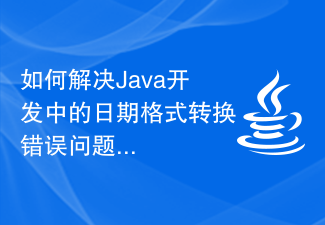 Backend Development
Backend Development Golang
Golang Technical difficulties and solutions in Go language project development
Technical difficulties and solutions in Go language project development
Technical difficulties and solutions in Go language project development
With the popularization of the Internet and the development of informatization, the development of software projects has received more and more attention. Among many programming languages, Go language has become the first choice of many developers because of its powerful performance, efficient concurrency capabilities and simple and easy-to-learn syntax. However, there are still some technical difficulties in the development of Go language projects. This article will explore these difficulties and provide corresponding solutions.
1. Concurrency control and race conditions
The concurrency model of Go language is called "goroutine", which makes concurrent development very simple. But concurrent development also faces some challenges, especially race conditions. Race conditions refer to the uncertainty in program output results in a multi-threaded environment due to the uncertainty in the order of thread execution. In Go language, you can use mutex or channel to solve the problem of race conditions. Mutex locks can be locked before accessing shared resources and released after the access is completed to ensure that only one goroutine can access the resource at the same time. The channel can send data from one goroutine to another goroutine, and automatically perform synchronization operations during the sending and receiving processes, thereby avoiding the occurrence of race conditions.
2. Performance Optimization
The performance of Go language is one of its biggest advantages, but in actual development, we still need to pay attention to some performance optimization issues. The first is the issue of memory allocation. The Go language uses a garbage collection mechanism to manage memory, but excessive memory allocation will increase the pressure of garbage collection, thereby affecting program performance. In order to reduce the number of memory allocations, you can use the Object Pool to save some commonly used objects and reuse these objects to reduce the number of memory allocations. In addition, for some time-consuming operations, parallelization can be used to improve program execution efficiency. The Go language provides support for parallelization. You can use goroutine and channel to implement concurrent execution of tasks and improve the parallelism and execution efficiency of the program.
3. Error handling and logging
In the development of Go language projects, error handling and logging are very important. Error handling includes not only error handling within the program, but also external errors, such as network request failures. The Go language provides a variety of ways to handle errors, including error codes, error types, and error chains. At the same time, by rationally using the defer and recover mechanisms, exception handling can be performed when an exception occurs in a function and the stability of the program can be ensured. Logging is also an indispensable part of project development. You can use the standard library of Go language or a third-party library to record logs and monitor and debug the running status of the program in real time.
4. Code Quality and Testing
Code quality is crucial to the maintainability and scalability of the project. In order to ensure code quality, you can use code static analysis tools and code formatting tools to inspect and optimize the code. Go language comes with some code tools such as go vet and gofmt, which can help developers standardize and check code. In addition, unit testing can also be used to verify and test the code to ensure the correctness and stability of the code. The Go language provides a powerful testing framework and supports parallel testing, which can quickly test and identify potential problems and improve development efficiency.
5. Version management and continuous integration
In the project development process, version management and continuous integration are very important. Version management can ensure collaboration and cooperation among team members, and can quickly roll back when problems arise. Git is currently the most popular version management tool, which can help developers manage code branches, merge code, and resolve conflicts. Continuous integration is a software development practice that enables early detection and resolution of problems by frequently integrating code into the trunk. There are currently many continuous integration tools to choose from, such as Jenkins, Travis CI, etc. You can choose the appropriate tool according to the needs of the project.
To sum up, the technical difficulties existing in Go language project development mainly include concurrency control and race conditions, performance optimization, error handling and logging, code quality and testing, version management and continuous integration, etc. . Solve the problem of concurrency control by flexibly using mutexes, channels, object pools, etc.; improve the performance of the program by optimizing memory allocation, parallelization, etc.; ensure the stability of the program through reasonable error handling and logging mechanisms; through code Static analysis, unit testing and other methods ensure the quality of the code; version management is carried out through Git and continuous integration using continuous integration tools to ensure the maintainability and scalability of the project. Only by fully understanding these technical difficulties and adopting corresponding solutions can we better develop high-quality Go language projects.
(Number of words: 940 words)
The above is the detailed content of Technical difficulties and solutions in Go language project development. For more information, please follow other related articles on the PHP Chinese website!
 如何解决Java开发中的日期格式转换错误问题Jun 29, 2023 am 09:40 AM
如何解决Java开发中的日期格式转换错误问题Jun 29, 2023 am 09:40 AM如何解决Java开发中的日期格式转换错误问题摘要:在Java开发过程中,经常会涉及到日期格式转换的问题。然而,在不同的场景下,可能会遇到不同的日期格式转换错误。本文将介绍一些常见的日期格式转换错误,并提供解决方案和示例代码。问题描述在Java开发中,日期格式转换错误可能出现在以下几个方面:1.1字符串到日期对象的转换:在从字符串转换为日期对象时,可能会遇到
 Go语言项目开发的技术难点与解决方法Nov 02, 2023 pm 06:51 PM
Go语言项目开发的技术难点与解决方法Nov 02, 2023 pm 06:51 PMGo语言项目开发的技术难点与解决方法随着互联网的普及和信息化的发展,软件项目的开发也越来越受到重视。在众多的编程语言中,Go语言因其强大的性能、高效的并发能力和简单易学的语法成为了众多开发者的首选。然而,Go语言项目开发中仍然存在一些技术难点,本文将探讨这些难点,并提供相应的解决方法。一、并发控制与竞态条件Go语言的并发模型被称为“goroutine”,它使
 Golang并发编程实践之Goroutines的应用场景分析Jul 18, 2023 pm 05:21 PM
Golang并发编程实践之Goroutines的应用场景分析Jul 18, 2023 pm 05:21 PMGolang并发编程实践之Goroutines的应用场景分析引言:随着计算机性能的不断提升,多核处理器已经成为了主流,为了充分利用多核处理器的优势,我们需要使用并发编程技术来实现多线程的操作。在Go语言中,Goroutines(协程)是一种非常强大的并发编程机制,它可以用来实现高效的并发操作,在本文中,我们将探讨Goroutines的应用场景,并给出一些示例
 在Go语言中如何解决并发任务的故障恢复问题?Oct 09, 2023 pm 05:36 PM
在Go语言中如何解决并发任务的故障恢复问题?Oct 09, 2023 pm 05:36 PM在Go语言中如何解决并发任务的故障恢复问题?在现代的软件开发中,利用并发处理能够显著提高程序的性能,在Go语言中,我们可以通过使用goroutine和channel来实现高效的并发任务处理。然而,并发任务也带来了一些新的挑战,如处理故障恢复。本文将介绍一些在Go语言中解决并发任务故障恢复问题的方法,并提供具体的代码示例。并发任务中的错误处理在处理并发任务时,
 如何处理Go语言中的并发文件压缩解压缩问题?Oct 08, 2023 am 08:31 AM
如何处理Go语言中的并发文件压缩解压缩问题?Oct 08, 2023 am 08:31 AM如何处理Go语言中的并发文件压缩解压缩问题?文件压缩和解压缩是日常开发中经常遇到的任务之一。随着文件大小的增加,压缩和解压缩操作可能会变得非常耗时,因此并发处理成为提高效率的一个重要手段。在Go语言中,可以利用goroutine和channel的特性,实现并发处理文件压缩和解压缩操作。文件压缩首先,我们来看一下如何在Go语言中实现文件的压缩操作。Go语言标准
 Python开发经验分享:如何进行有效的调试和错误处理Nov 22, 2023 pm 04:36 PM
Python开发经验分享:如何进行有效的调试和错误处理Nov 22, 2023 pm 04:36 PMPython作为一种功能强大、应用广泛的编程语言,在软件开发领域中受到了越来越多的关注和应用。在日常的开发工作中,经常会遇到各种各样的bug和错误,因此在Python开发中进行有效的调试和错误处理是非常重要的。本文将分享一些个人在Python开发中积累的经验,希望对初学者和开发者们有所帮助。有效的调试技巧在进行Python开发时,遇到bug或者需求变更是无法
 刨析Vue的服务器端通信策略:如何处理错误和异常Aug 11, 2023 am 09:12 AM
刨析Vue的服务器端通信策略:如何处理错误和异常Aug 11, 2023 am 09:12 AM刨析Vue的服务器端通信策略:如何处理错误和异常在开发Web应用程序时,与服务器进行通信是必不可少的一项任务。Vue.js作为一种流行的前端框架,提供了一套强大的工具和方法来处理与服务器端的通信。在这篇文章中,我们将重点探讨Vue的服务器端通信策略,并着重讨论如何在处理错误和异常时有效地利用这些策略。在Vue中,我们通常使用axios来处理服务器端通信。Ax
 PHP 错误处理:保护用户数据的有效方法Aug 07, 2023 am 09:36 AM
PHP 错误处理:保护用户数据的有效方法Aug 07, 2023 am 09:36 AMPHP错误处理:保护用户数据的有效方法引言:在开发Web应用程序时,正确处理PHP错误是保护用户数据和应用程序安全的重要方面。错误处理不仅能提高应用程序的健壮性,还可以避免敏感信息被泄露。本文将介绍几种有效方法来处理PHP错误和保护用户数据。一、使用异常处理异常处理是PHP中一种灵活且强大的机制,用于捕获和处理错误。通过抛出异常,我们可以在异常处理程序中处


Hot AI Tools

Undresser.AI Undress
AI-powered app for creating realistic nude photos

AI Clothes Remover
Online AI tool for removing clothes from photos.

Undress AI Tool
Undress images for free

Clothoff.io
AI clothes remover

AI Hentai Generator
Generate AI Hentai for free.

Hot Article

Hot Tools

EditPlus Chinese cracked version
Small size, syntax highlighting, does not support code prompt function

Safe Exam Browser
Safe Exam Browser is a secure browser environment for taking online exams securely. This software turns any computer into a secure workstation. It controls access to any utility and prevents students from using unauthorized resources.

Dreamweaver CS6
Visual web development tools

SublimeText3 Linux new version
SublimeText3 Linux latest version

mPDF
mPDF is a PHP library that can generate PDF files from UTF-8 encoded HTML. The original author, Ian Back, wrote mPDF to output PDF files "on the fly" from his website and handle different languages. It is slower than original scripts like HTML2FPDF and produces larger files when using Unicode fonts, but supports CSS styles etc. and has a lot of enhancements. Supports almost all languages, including RTL (Arabic and Hebrew) and CJK (Chinese, Japanese and Korean). Supports nested block-level elements (such as P, DIV),





